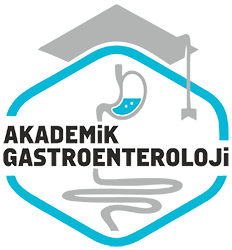Dispepsili hastalarda midenin prekanseröz lezyonlari ile karsilasma riski
The risk of encountering with gastric precancerous lesions in dyspeptic patients
Özet
Giriş ve amaç: Intestinal tip mide kanserinin patogenezinde atrofik gas trit-intestinal metaplazi-displazi- kanser sürecinin önemi bilinmektedir. Bu çalışmada mide kanser izlem programlari içinde iyi bir veri tabani saglayabilecegi öngörüsüyle dispepsili olgularda midedeki prekanseröz lezyon (atrofi, intestinal metaplazi, displazi) oranlarini belirlemeyi amaçladık. Gereç ve yöntem: çalışmaya 2003 Haziran-2004 Subat aylari arasında dispepsi nedeni ile üst gastrointestinal endoskopi yapılan ardi sik 285 hasta (161 kadın, 124 erkek, yaş ortalaması 55.8, yaş araligi 16-80) alındı. Bu hastalardan güncellestirilmis Sidney sistemine göre antrum ve korpustan toplam 5 biyopsi alındı ve histopatolojik değerlendirme yapildi. Bulgular: Bu Hastaların %8’inde (24 hasta) atrofik gastrit, %21’inde (61 hasta) intestinal metaplazi (komplet ve inkomplet), %4’ünde (13 hasta) displazi saptandi. Mide kanseri için prekanseröz lezyonlar saptanan 98 olgunun %90’inda (89 hasta) H. pylori (+) iken, prekanseröz lezyon saptanmayan 187 olgunun ise %61’inde (115 hasta) H. pylori (+) bulundu ve istatiksel olarak anlamli fark bulundu. Sonuç: Dispepsi nedeniyle üst gastrointestinal endoskopi yapılan hastalarda midenin prekanseröz lezyonlari (atrofi, intestinal metaplazi, displazi) saptanabilir. Intestinal tip gastrik kanserle H. pylori arasındaki güçlü ilişkiyi dogrulayacak şekilde prekanseröz lezyon bulunan hastalarda bu bakteri yüksek oranda saptanmıştır.
Abstract
Background/aim: In the pathogenesis of intestinal type gastric cancer, the importance of the process of atrophic gastritis-intestinal metaplasiadysplasia- cancer is well known. In this study, assuming that it will provide a good database in gastric cancer follow-up programs, we intended to establish the rates of gastric precancerous lesion (atrophy, intestinal metaplasia, and dysplasia) in patients with dyspepsia. Materials and methods: From June 2003 - February 2004, 310 consecutive patients (172 females, 138 males, mean age 55.8, range 16-80) who applied for gastrointestinal endoscopy due to dyspepsia were included in the study. Five biopsies were taken from the antrum and corpus of these patients using the updated Sidney system and were examined histopathologically. Results: In these patients, we determined 8% (24 patients) with atrophic gastritis, 20% (61 patients) with intestinal metaplasia (complete or incomplete), and 4% (13 patients) with dysplasia. While H. pylori was (+) in 90% (89 patients) of 98 cases with precancerous lesions, H. pylori was (+) in 61% (115 patients) of 187 patients without precancerous lesions, and the difference was statistically significant. Conclusion: Several precancerous lesions may be detected in the stomach of patients in whom endoscopic examinations are performed due to dyspepsia. Verifying the strong relationship between intestinal type gastric cancers and H. pylori, this bacteria was found at a high rate in patients with precancerous lesions.



